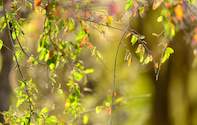
Over the past few months people visiting and working in the Kruger National Park have been concerned and interested in two insect eruptions which have occurred. There is no need for concern as both species are indigenous. When environmental conditions are favourable, eruptions of certain insect species occur periodically.
In January and February many people were concerned about charcoal-coloured caterpillars which were completely defoliating the tamboti trees (Spirostachys africana). The trees have all recovered and they are once again in full leaf.
This caterpillar is Achaea catella or the banded achaea. Achaea is a fairly large genus from the family Noctuidae. Army worms and cutworms also belong to this family. Apart from the larvae feeding on tamboti, they are also known to feed on bauhinia species, and apple-leaf (Philenoptera violacea). In 1991 the same phenomenon occurred on tamboti.
At the moment many people will notice large, black and red spiny caterpillars on the cape-ash (Ekebergia capensis). These caterpillars are Bunaea alcinoë or the common emperor moth. The larvae also feed on other genera of plants such as Bauhinia, Croton, Cussonia and Gymnosporia. However, in Kruger they are more commonly seen on the cape-ash. The caterpillars are eaten by the Venda people and are also eaten in other parts of Africa.
The common emperor moth belongs to the same family as the mopane worm (Saturnidae). Emperor moths are characterized by having large wings and distinctive "eyespots" on the wings. Their bodies are heavily scaled giving them a "fluffy" appearance.By Guin Zambatis
Skukuza Biological Reference Collection

